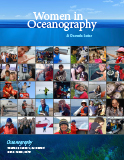First Paragraph
There is good news and bad news for twenty-first century women oceanographers. Tremendous progress has been made in breaking the glass ceiling, both in positions and in prestigious awards and medals (Table 1). There were many firsts, including the first woman to head the National Oceanic and Atmospheric Administration (NOAA; Jane Lubchenco) and the first woman to head the United States Geological Survey (USGS; Marcia McNutt). Commendably, other women are succeeding the first women in these very high level positions. Kathy Sullivan, the first woman to walk in space, succeeds Lubchenco. McNutt's successor at the USGS not been confirmed; however, Suzette Kimball, has been nominated to succeed her and is serving as Acting Director.

